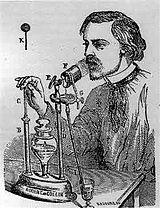That’s a great success story! Thank you for sharing that!
I just got over having double pneumonia and vaping wasn’t giving me any issues at all during that time. I actually think it helped.
Its funny you mention that @Bearkat , vaping has always reminded me just a little bit of the nebulizar treatments I used to have to give to my nephew…
Here’s a fun fact that I just read:
“The first “powered” or pressurized inhaler was invented in France by Sales-Girons in 1858.This device used pressure to atomize the liquid medication. The pump handle is operated like a bicycle pump. When the pump is pulled up, it draws liquid from the reservoir, and upon the force of the user’s hand, the liquid is pressurized through an atomizer, to be sprayed out for inhalation near the user’s mouth”

Sales-Girons pressurized
nebulizer from 1858.
So I guess vaping has been around since the mid 1800’s.
Here’s the rest of the history:
In 1864, the first steam-driven nebulizer was invented in Germany. This inhaler, known as “Siegle’s steam spray inhaler”, used the Venturi principle to atomize liquid medication, and this was the very beginning of nebulizer therapy. The importance of droplet size was not yet understood, so the efficacy of this first device was unfortunately mediocre for many of the medical compounds. The Siegle steam spray inhaler consisted of a spirit burner, which boiled water in the reservoir into steam that could then flow across the top and into a tube suspended in the pharmaceutical solution. The passage of steam drew the medicine into the vapor, and the patient inhaled this vapor through a mouthpiece made of glass.
The first electrical nebulizer was invented in the 1930s and called a Pneumostat. With this device, a medical liquid (typically adrenalin chloride, used as a bronchial muscle relaxant to reverse contriction) was made aerosol by the power from an electrical compressor. As an alternative to the expensive electrical nebulizer, many people in the 1930s continued to use the much more simple and cheap hand-driven nebulizer, known as the Parke-Davis Glaseptic.
In 1956, a technology competing against the nebulizer was launched by Riker Laboratories (3M), in the form of pressurized metered-dose inhalers, with Medihaler-iso (isoprenaline) and Medihaler-epi (adrenaline) as the two first products. In these devices, the drug is cold-fill and delivered in exact doses through some special metering valves, driven by a gas propellant technology (i.e. Freon or a less environmentally damaging HFA).
In 1964, a new type of electronic nebulizer was introduced: the “ultrasonic wave nebulizer”. Today the nebulizing technology is not only used for medical purposes. Ultrasonic wave nebulizers are also used in humidifiers, to spray out water aerosols to moisten dry air in buildings.
Some of the first models of electronic cigarettes featured an ultrasonic wave nebulizer (having a piezoelectric element vibrating and creating high-frequency ultrasound waves, to cause vibration and atomization of liquid nicotine) in combination with a vapouriser (built as a spray nozzle with an electric heating element). The most common type of electronic cigarettes currently sold, however, omit the ultrasonic wave nebulizer, as it was not found to be efficient enough for this kind of device. Instead, the electronic cigarettes now use an electric vaporizer, either in direct contact with the absorbent material in the “impregnated atomizer,” or in combination with the nebulization technology related to a “spraying jet atomizer” (in the form of liquid droplets being out-sprayed by a high-speed air stream, that passes through some small venturi injection channels, drilled in a material absorbed with nicotine liquid)."
I gotta tell you…this is a perfect example of why I love this site so much. The sheer volume of raw information freely provided, by people taking time out their schedule to research, that is important to know if you wish to speak intelligently about this crazy thing we all do called Vaping. The site may be ELR but it goes WAY WAY beyond simple recipe sourcing.
Thanks for this Bear!!!
I’m not diabetic and to the best of my knowledge have no medical anything wrong with me and I stopped adding sweetener to mixes a while ago but not even for health-concern purposes: I stopped adding it because it tastes artificial, even compared to the artificial flavourings we’re always using.
Got some Sweet Honey flavour and found that not only adds the taste of honey but the taste of sweetness of honey too, yet if I lick-test my juice it doens’t taste any sweeter, which doesn’t matter course since I vapoe the shit - not lick it - generally, so as long as you’ve got the flavour of sweetness there’s no need to ruin the mix with some cheap-tasting sweetener.
Brown/Raw/Cane sugar, date flavour, many other flavours are also designed to taste sweet without actually containing additional sweetnener, so now I would much rather take that approach than to add anything that only sweetens.
See, I can give a serious, considered answer - it’s a thing 
Gosh, I could’ve saved myself the effort of typing that post out with my thumb…
Dunno WHY posts that old find their way into the currently active topics, but oh wells.
A spammer necroposted
Ahh…
I’m sure I spotted a bot the other day - within minutes of their first post: some brunette chick avatar with usename bbbonbon.
I called em a bot, next morning all half dozen of the posts they’d posted were gone! 
It was just like, way too easy to pick the pattern in the similarities between their posts.
- All were one line replies.
- All ending in 3-4 emoticons.
- All looked as though a PHP script could’ve word-matched the title of the post and based the reply off the title.
- All the replies were to the first half dozen or so popular threads.
Not screaming they were a bot, but each post was just too similar in composition.